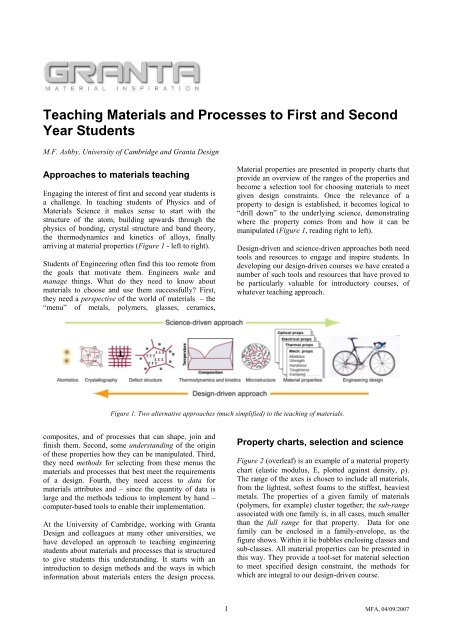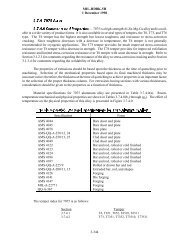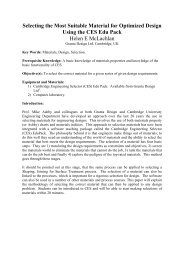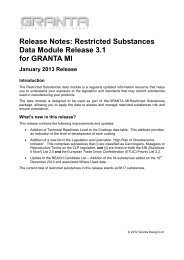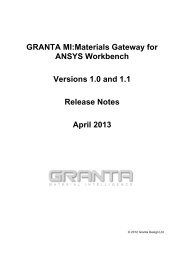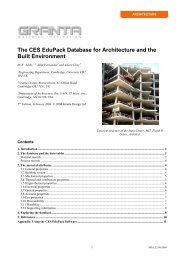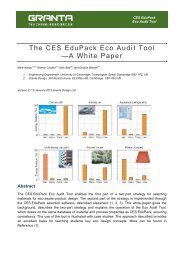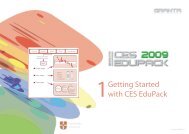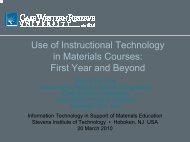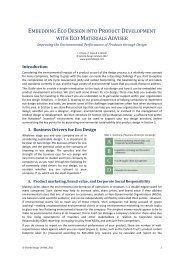New Approaches to Materials Education for ... - Granta Design
New Approaches to Materials Education for ... - Granta Design
New Approaches to Materials Education for ... - Granta Design
Create successful ePaper yourself
Turn your PDF publications into a flip-book with our unique Google optimized e-Paper software.
Acrylonitrile butadiene styrene (ABS)The MaterialABS (Acrylonitrile-butadiene-styrene) is <strong>to</strong>ugh, resilient, and easily molded. It is usuallyopaque, although some grades can now be transparent, and it can be given vividcolors. ABS-PVC alloys are <strong>to</strong>ugher than standard ABS and, in self-extinguishinggrades, are used <strong>for</strong> the casings of power <strong>to</strong>ols.General propertiesDensity 1e3 - 1.2e3 kg/m 3Price 2 - 2.7 USD/kgMechanical propertiesYoung's modulusHardness - VickersElastic limitTensile strengthCompressive strengthElongationEndurance limitFracture <strong>to</strong>ughness1.15.61928311.5111.2--------2.9155155861e2224.3GPaHVMPaMPaMPa%MPaMPa.m 1/2 Thermal propertiesThermal conductivity 0.19 - 0.34 W/m.KThermal expansion 85 - 230 µstrain/°CSpecific heat 1400 - 1900 J/kg.KGlass Temperature 88 - 130 °CMax service temp. 62 - 90 °CElectrical propertiesResistivity 2.3e21- 3e22 µohm.cmDielectric constant 2.8 - 2.2Typical usesSafety helmets; camper <strong>to</strong>ps; au<strong>to</strong>motive instrument panels and other interior components; pipe fittings; home-security devicesand housings <strong>for</strong> small appliances; communications equipment; business machines; plumbing hardware; au<strong>to</strong>mobile grilles; wheelcovers; mirror housings; refrigera<strong>to</strong>r liners; luggage shells; <strong>to</strong>te trays; mower shrouds; boat hulls; large components <strong>for</strong> recreationalvehicles; weather seals; glass beading; refrigera<strong>to</strong>r breaker strips; conduit; pipe <strong>for</strong> drain-waste-vent (DWV) systems.Figure 3. Part of a record <strong>for</strong> ABS from the CES EduPack materials in<strong>for</strong>mation softwareand Engineering of <strong>Materials</strong>” (4), all of which take thescience-led route, can be augmented and rein<strong>for</strong>ced withsoftware-based exercises <strong>to</strong> explore the world ofmaterials.We have developed the design-led approach in anumber of texts, of which two are appropriate <strong>for</strong> firstand second year teaching. A new text “<strong>Materials</strong>:engineering, science, processing and design” (5)introduces key methods and illustrates their application<strong>to</strong> the use of materials in mechanical, thermal, electromagneticand optical design. It offers a high degree ofintegration with CES EduPack, including exercisesusing the software. “<strong>Materials</strong> and <strong>Design</strong>” (6)addresses issues of industrial design, providing anintroduction <strong>to</strong> materials <strong>for</strong> students of product design.“<strong>Materials</strong> Selection in Mechanical <strong>Design</strong>” (7) is amore advanced text, developing the methods <strong>to</strong> a higherlevel, one appropriate <strong>for</strong> third, fourth year and masterslevel teaching. All three have numerous exercises <strong>for</strong>which solution manuals are available.Project-based teachingThe CES EduPack provides a resource <strong>for</strong> project-basedteaching. The projects that we use <strong>for</strong> first and secondyear students focus on analyzing material choice <strong>for</strong>familiar products, avoiding at this early stage the need<strong>for</strong> a detailed understanding of complex systems.In the Bicycle Project, <strong>for</strong> example, students are firstasked <strong>to</strong> select a component of a bicycle (frame, <strong>for</strong>ks,saddle, spokes, brake-cable…) and a user group (e.g.,children, shoppers, <strong>to</strong>uring use, sprint, mountainbiking…) <strong>for</strong> which the design is intended. They arethen asked <strong>to</strong> <strong>for</strong>mulate the requirements if the productis <strong>to</strong> meet the needs of that group and the objectiveappropriate <strong>to</strong> it (minimizing weight or cost,maximizing robustness…). These provide the inputs <strong>for</strong>the CES EduPack software, which delivers a ranked lis<strong>to</strong>f suitable candidates, datasheets <strong>for</strong> their properties,and suggested manufacturing routes.Redesign <strong>to</strong> reduce the environmental impact of aproduct is a rich source of projects. The students mustdecide which phase of life (material production, productmanufacture, product use, disposal at end of life) posesthe greatest environmental problem, and then selectappropriate materials <strong>to</strong> minimize this. The CES systemprovides all the resources <strong>to</strong> enable projects of this sort.SummaryFirst and second year students need: a materialsperspective, methods, <strong>to</strong>ols and understanding <strong>to</strong> enablethe rational selection and use of materials. Strong linkswith design, <strong>for</strong> example via a design-driven teachingapproach, can provide immediate integration with theother engineering subjects. Whatever approach isadopted, the simplicity and visual impact of propertycharts offer valuable support, particularly withincomputer-based <strong>to</strong>ols such as CES EduPack.Experience shows that students like such <strong>to</strong>ols, whichmotivate them <strong>to</strong> explore materials <strong>for</strong> themselves.Such software also provides exportable skills: studentsgain an insight in<strong>to</strong> professional-level engineering <strong>to</strong>ols.3 MFA, 04/09/2007
References(1) CES EduPack 2007, <strong>Granta</strong> <strong>Design</strong>, Cambridge(2007), www.grantadesign.com.(2) Callister, W.D. (2003) “<strong>Materials</strong> Science andEngineering: An Introduction”, J.W. Wiley and Sons,NY, USA(3) Budinski, K.G. and Budinski, M.K (1999)“Engineering <strong>Materials</strong>, Properties and Selection”, 6 thedition, Prentice Hall, Columbus, Ohio, USA.(4) Askland, D.R. (1984), “The Science andEngineering of <strong>Materials</strong>”, Wadsworth, Calif. USA.(5) Ashby, M.F. Shercliff, H. and Cebon, D. (2007)“<strong>Materials</strong>: engineering, science, processing anddesign”, Butterworth Heinemann, Ox<strong>for</strong>d UK.(6) Ashby, M.F. and Johnson, K. (2002) “<strong>Materials</strong> and<strong>Design</strong>”, Butterworth Heinemann, Ox<strong>for</strong>d, UK.(7) Ashby, M.F. (2005) “<strong>Materials</strong> Selection inMechanical <strong>Design</strong>”, 3rd edition, Butterworth-Heinemann, Ox<strong>for</strong>d, UK.4 MFA, 04/09/2007



